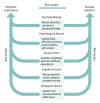Association of Psychotic Experiences With Subsequent Risk of Suicidal Ideation, Suicide Attempts, and Suicide Deaths: A Systematic Review and Meta-analysis of Longitudinal Population Studies
- PMID: 30484818
- PMCID: PMC6439738
- DOI: 10.1001/jamapsychiatry.2018.3514
Association of Psychotic Experiences With Subsequent Risk of Suicidal Ideation, Suicide Attempts, and Suicide Deaths: A Systematic Review and Meta-analysis of Longitudinal Population Studies
Abstract
Importance: Recent research has highlighted that psychotic experiences are far more prevalent than psychotic disorders and associated with the full range of mental disorders. A particularly strong association between psychotic experiences and suicidal behavior has recently been noted.
Objective: To provide a quantitative synthesis of the literature examining the longitudinal association between psychotic experiences and subsequent suicidal ideation, suicide attempts, and suicide deaths in the general population.
Data sources: We searched PubMed, Excerpta Medica Database, Cumulative Index to Nursing and Allied Health Literature, and PsycINFO from their inception until September 2017 for longitudinal population studies on psychotic experiences and subsequent suicidal ideation, suicide attempts, and suicide death.
Study selection: Two authors searched for original articles that reported a prospective assessment of psychotic experiences and suicidal ideation, suicide attempts, or suicide death in general population samples, with at least 1 follow-up point.
Data extraction and synthesis: Two authors conducted independent data extraction. Authors of included studies were contacted for information where necessary. We assessed study quality using the Newcastle-Ottawa Quality Assessment Scale. We calculated pooled odds ratios using a random-effects model. A secondary analysis assessed the mediating role of co-occurring psychopathology.
Main outcomes and measures: Psychotic experiences and subsequent suicidal ideation, suicide attempts, and suicide death.
Results: Of a total of 2540 studies retrieved, 10 met inclusion criteria. These 10 studies reported on 84 285 participants from 12 different samples and 23 countries. Follow-up periods ranged from 1 month to 27 years. Individuals who reported psychotic experiences had an increase in the odds of future suicidal ideation (5 articles; n = 56 191; odds ratio [OR], 2.39 [95% CI,1.62-3.51]), future suicide attempt (8 articles; n = 66 967; OR, 3.15 [95% CI, 2.23-4.45]), and future suicide death (1 article; n = 15 049; OR, 4.39 [95% CI, 1.63-11.78]). Risk was increased in excess of that explained by co-occurring psychopathology: suicidal ideation (adjusted OR, 1.59 [95% CI, 1.09-2.32]) and suicide attempt (adjusted OR, 2.68 [95% CI, 1.71-4.21]).
Conclusions and relevance: Individuals with psychotic experiences are at increased risk of suicidal ideation, suicide attempts, and suicide death. Psychotic experiences are important clinical markers of risk for future suicidal behavior.
Conflict of interest statement
Figures




Similar articles
-
Suicidal ideation and suicide attempts among adults with psychotic experiences: data from the Collaborative Psychiatric Epidemiology Surveys.JAMA Psychiatry. 2015 Mar;72(3):219-25. doi: 10.1001/jamapsychiatry.2014.2663. JAMA Psychiatry. 2015. PMID: 25715312
-
Psychotic Experiences and Risk of Suicidal Thoughts and Behaviors: A Systematic Review and Meta-Analysis of Longitudinal Population Studies.Schizophr Bull. 2024 Nov 16:sbae197. doi: 10.1093/schbul/sbae197. Online ahead of print. Schizophr Bull. 2024. PMID: 39550208
-
Association Between Atopic Dermatitis and Suicidality: A Systematic Review and Meta-analysis.JAMA Dermatol. 2019 Feb 1;155(2):178-187. doi: 10.1001/jamadermatol.2018.4566. JAMA Dermatol. 2019. PMID: 30540348 Free PMC article.
-
Risk of suicidal ideation, suicide attempts, and suicide deaths in persons with sleep apnea: Protocol for a systematic review and meta-analysis.PLoS One. 2020 Jul 6;15(7):e0235379. doi: 10.1371/journal.pone.0235379. eCollection 2020. PLoS One. 2020. PMID: 32628722 Free PMC article.
-
Self-injurious thoughts and behaviors as risk factors for future suicide ideation, attempts, and death: a meta-analysis of longitudinal studies.Psychol Med. 2016 Jan;46(2):225-36. doi: 10.1017/S0033291715001804. Epub 2015 Sep 15. Psychol Med. 2016. PMID: 26370729 Free PMC article. Review.
Cited by
-
Composite immune marker scores associated with severe mental disorders and illness course.Brain Behav Immun Health. 2022 Jul 2;24:100483. doi: 10.1016/j.bbih.2022.100483. eCollection 2022 Oct. Brain Behav Immun Health. 2022. PMID: 35856063 Free PMC article.
-
What drives beliefs in COVID-19 conspiracy theories? The role of psychotic-like experiences and confinement-related factors.Soc Sci Med. 2022 Jan;292:114611. doi: 10.1016/j.socscimed.2021.114611. Epub 2021 Nov 27. Soc Sci Med. 2022. PMID: 34864602 Free PMC article.
-
Self-harm, suicidal ideation, and the positive symptoms of psychosis: Cross-sectional and prospective data from a national household survey.Schizophr Res. 2021 Jul;233:80-88. doi: 10.1016/j.schres.2021.06.021. Epub 2021 Jul 7. Schizophr Res. 2021. PMID: 34246091 Free PMC article.
-
Cognitive Biases and Socio-Occupational Functioning Mediate the Relationship between Executive Functions and the Severity of Psychopathology among Young Adults with Psychotic-like Experiences: 1-Year Follow-Up Study.Brain Sci. 2024 Mar 5;14(3):256. doi: 10.3390/brainsci14030256. Brain Sci. 2024. PMID: 38539644 Free PMC article.
-
Suicide behavior is associated with childhood emotion dysregulation but not trait impulsivity in first episode psychosis.Psychiatry Res. 2020 Dec;294:113517. doi: 10.1016/j.psychres.2020.113517. Epub 2020 Oct 22. Psychiatry Res. 2020. PMID: 33113453 Free PMC article.
References
-
- Linscott RJ, van Os J. An updated and conservative systematic review and meta-analysis of epidemiological evidence on psychotic experiences in children and adults: on the pathway from proneness to persistence to dimensional expression across mental disorders. Psychol Med. 2013;43(6):1133-1149. doi:10.1017/S0033291712001626 - DOI - PubMed
Publication types
MeSH terms
LinkOut - more resources
Full Text Sources
Other Literature Sources
Medical
Miscellaneous

